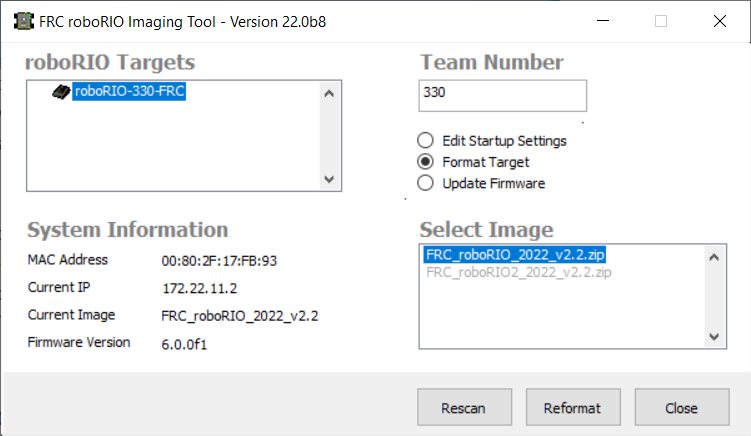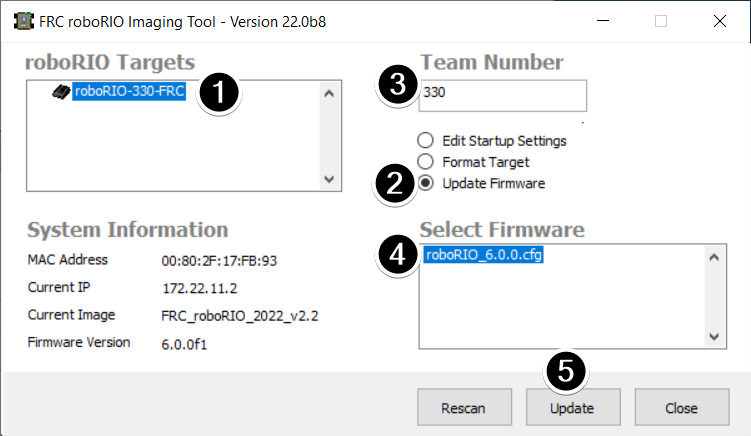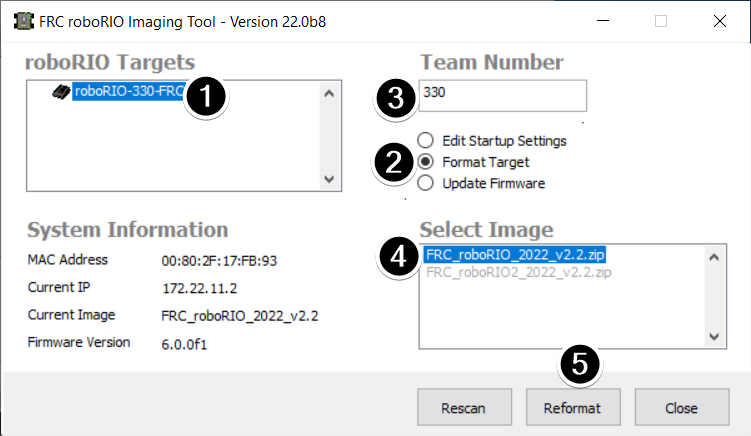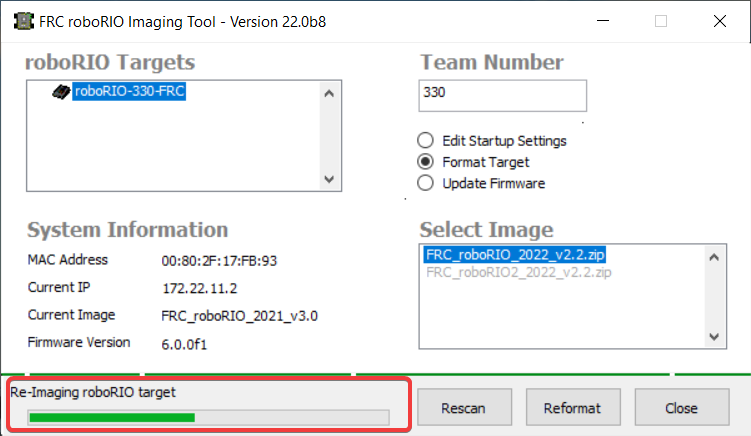Imaging your roboRIO 1
אזהרה
Before imaging your roboRIO, you must have completed installation of the FRC Game Tools. You also must have the roboRIO power properly wired to the Power Distribution Panel. Make sure the power wires to the roboRIO are secure and that the connector is secure firmly to the roboRIO (4 total screws to check).
הערה
The roboRIO 2 uses different imaging instructions. The imaging instructions for the NI roboRIO 2.0 are here.
Configuring the roboRIO
The roboRIO Imaging Tool will be used to image your roboRIO with the latest software.
USB Connection
Connect a USB cable from the roboRIO USB Device port to the PC. This requires a USB Type A male (standard PC end) to Type B male cable (square with 2 cut corners), most commonly found as a printer USB cable.
הערה
The roboRIO should only be imaged via the USB connection. It is not recommended to attempt imaging using the Ethernet connection.
Driver Installation
The device driver should install automatically. If you see a ”New Device“ pop-up in the bottom right of the screen, wait for the driver install to complete before continuing.
Launching the Imaging Tool

The roboRIO imaging tool and latest image are installed with the NI FRC® Game Tools. Launch the imaging tool by double clicking on the shortcut on the Desktop. If you have difficulties imaging your roboRIO, you may need to try right-clicking on the icon and selecting Run as Administrator instead.
הערה
The roboRIO imaging tool is also located at C:\Program Files (x86)\National Instruments\LabVIEW 2023\project\roboRIO Tool
roboRIO Imaging Tool

After launching, the roboRIO Imaging Tool will scan for available roboRIOs and indicate any found in the top left box. The bottom left box will show information and settings for the roboRIO currently selected. The right hand pane contains controls for modifying the roboRIO settings:
Edit Startup Settings - This option is used when you want to configure the startup settings of the roboRIO (the settings in the right pane), without imaging the roboRIO.
Format Target - This option is used when you want to load a new image on the roboRIO (or reflash the existing image). This is the most common option.
Update Firmware - This option is used to update the roboRIO firmware. For this season, the imaging tool will require roboRIO firmware to be version 5.0 or greater.
Updating Firmware
אזהרה
It is only necessary to update the firmware on a brand new roboRIO. It is not recommended to update the firmware unless it doesn’t meet the conditions below.

roboRIO firmware must be at least v5.0 to work with the 2019 or later image. If your roboRIO is at least version 5.0 (as shown in the bottom left of the imaging tool) you do not need to update.
הערה
roboRIO firmware has had different version numbering schemes over the years. It isn’t necessary to update the firmware if it has version 5, 6, 8, 22.5, 23.5 or variations of those version numbers (e.g. 8.8.0f0 is a variation of 8). The firmware is only utilized in safe mode, it is not used in normal operations.
To update roboRIO firmware:
Make sure your roboRIO is selected in the top left pane.
Select Update Firmware in the top right pane
Enter a team number in the Team Number box
Select the latest firmware file in the bottom right
Click the Update button
Imaging the roboRIO
אזהרה
The roboRIO image is different then the firmware, and must be updated yearly.

הערה
The available image versions will not show until you select Format Target per step 2 below.
Make sure the roboRIO is selected in the top left pane
Select Format Target in the right pane
Enter a team number in the Team Number box
Select the latest image version in the box.
Click Reformat to begin the imaging process.
Imaging Progress

The imaging process will take approximately 3-10 minutes. A progress bar in the bottom left of the window will indicate progress.
Imaging Complete

When the imaging completes you should see the dialog above. Click Ok, then click the :guilabel`Close` button at the bottom right to close the imaging tool. Reboot the roboRIO using the Reset button to have the new team number take effect.
פתרון בעיות
If you are unable to image your roboRIO, troubleshooting steps include:
Try running the roboRIO Imaging Tool as Administrator by right-clicking on the Desktop icon to launch it.
Try accessing the roboRIO webpage with a web-browser at
http://172.22.11.2/and/or verify that the NI network adapter appears in your list of Network Adapters in the Control Panel. If not, try re-installing the NI FRC Game Tools or try a different PC.Make sure your firewall is turned off.
Some teams have experienced an issue where imaging fails if the device name of the computer you’re using has a special character (e.g. dash
-), or number in it, or the name is too long. Try renaming the computer (or using a different PC). On Windows 11, to rename the PC, go to Settings > System > About and click Rename this PCTry booting the roboRIO into Safe Mode by pressing and holding the reset button for at least 5 seconds.
Try a different USB Cable
Try a different PC
If the status LED is constantly flashing, and imaging in safe mode failed, follow the roboRIO recovery instructions
If the correct roboRIO image version isn’t available:
Ensure you’ve selected Format Target
If an older version is shown, ensure you’ve installed the latest FRC Game Tools
If the wrong version still shown after installing Game Tools, Uninstall Game Tools and then re-install.